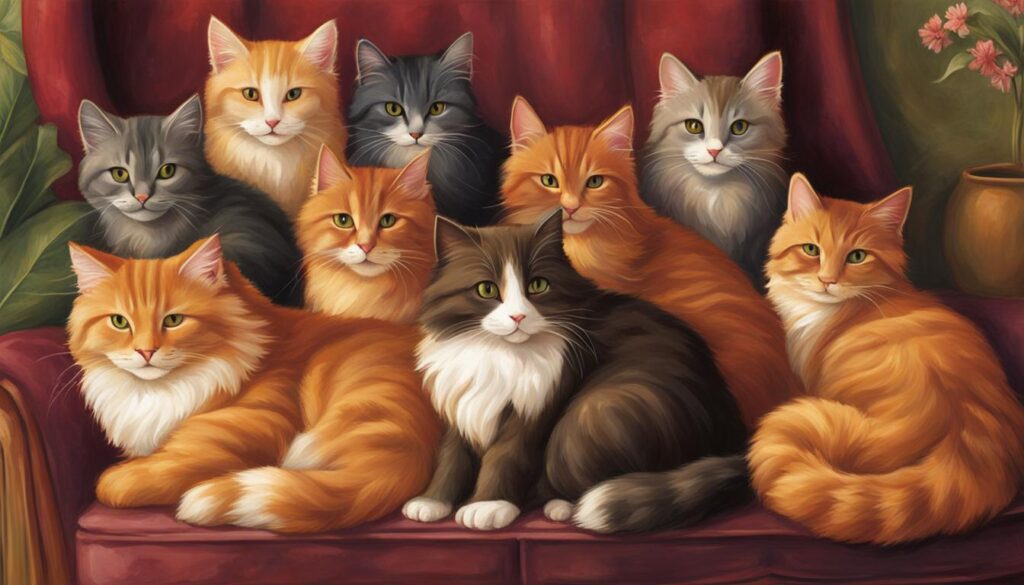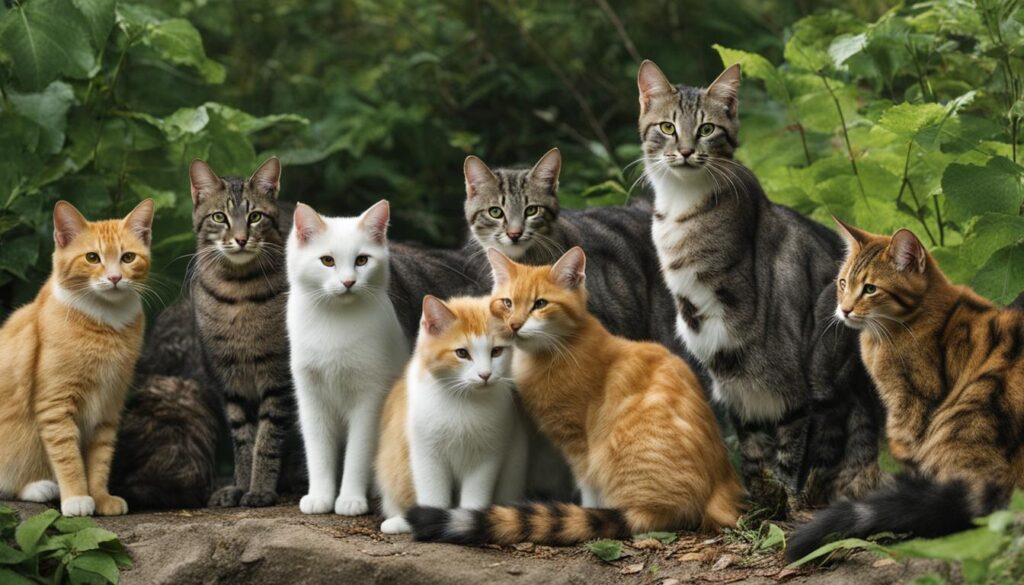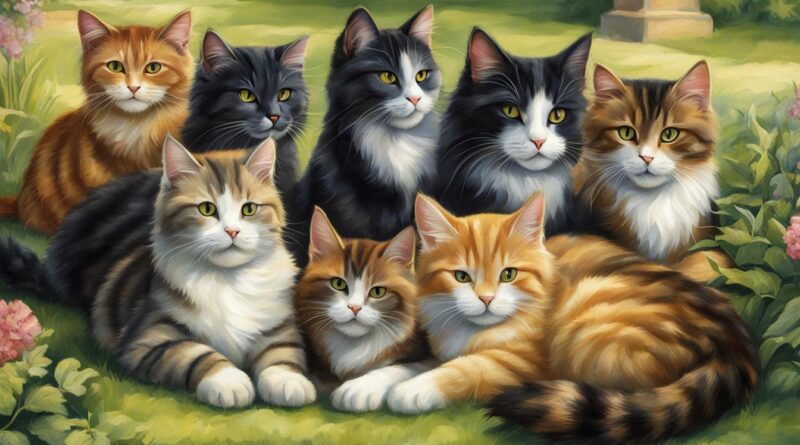Group of Cats: What Do You Call Them? Learn Here!
Have you ever wondered what to call a group of cats? While they can simply be referred to as “cats,” there are actually some unique and interesting names for a gathering of these feline creatures. Let’s explore the fascinating world of cat group names!
Key Takeaways:
- A group of cats can be called a “clowder,” “clutter,” or “glaring.”
- Other names for a cat group include “cluster,” “destruction,” “dout,” and “nuisance.”
- Feral cats form colonies, while domestic cats in multi-cat households have their own unique dynamics.
- Understanding cat group names and behaviors can enhance our appreciation for these fascinating animals.
- Next time you encounter a bunch of cats, impress your friends with these interesting and quirky cat group names!
The Etymology of “Cat”
The word cat has an interesting etymology. It comes from the Old English word catt, which originated from the Late Latin word catus, meaning “domestic cat.” There are theories that suggest the Latin word came from the Afro-Asiatic word kaddîska, which translates to “wild cat.” This connection to “wild cat” makes sense considering that cats were once wild animals before being domesticated. It’s also worth noting that the Egyptian word for cat is mau, which sounds similar to the sound “meow.”
Odd Names for Individual Cats
In addition to unique names for groups of cats, individual cats also have some interesting names associated with them. Each gender has its own specific title, contributing to the charm and personality of our feline companions. Let’s explore these peculiar names:
- A male cat is called a tom.
- A neutered male cat goes by the name gib.
- A female cat, on the other hand, is commonly known as a molly.
- During pregnancy, a female cat is referred to as a queen.
In British English, a feline mutt is humorously described as a moggy. These distinct names add an extra touch of character to our beloved feline friends.
| Gender | Name |
|---|---|
| Male | Tom |
| Neutered Male | Gib |
| Female | Molly |
| Pregnant Female | Queen |
| British English | Moggy |
The Term for a Group of Cats
When it comes to describing a gathering of cats, there is an official term – a clowder. The word “clowder” originated from the Old English term “clott,” which means “round mass or lump.” Over time, it evolved into “clutter” and eventually became “clowder.” So, the next time you see a group of cats together, you can impress your friends with this interesting term.
But the term “clowder” is not the only one used to describe a group of cats. In certain situations, the term “glaring” can also be applicable. A “glaring” is a group of cats that do not know each other well. While this term is rarely used, it adds an intriguing touch to the vocabulary of cat enthusiasts.
Understanding these terms not only shows our appreciation for feline gatherings but also gives us a deeper insight into the social dynamics of cats. It’s fascinating how language evolves to capture the essence of our furry friends!

Other Names for Groups of Cats
While the most common term for a group of cats is a “clowder,” there are alternative names that can be used depending on the context. These unique names add variety and interest when describing a gathering of our feline friends. Some of these alternative names for groups of cats include:
- Cluster
- Clutter
- Destruction
- Dout
- Nuisance
- Pounce
Although these names may not be as well-known or widely used as “clowder,” they provide a creative and fun way to describe a group of cats. So, the next time you see a bunch of cats huddled together, you can impress your friends with one of these alternative names!
Cats in the Wild
In the wild, feral cats have a tendency to form groups known as colonies. These colonies are typically composed of related cats, such as mothers and their kittens. Unlike domestic cats, feral cats within a colony do not operate with a hierarchical structure like a pack of dogs. Instead, they share a common territory while hunting independently. However, it is not uncommon for certain cats within the colony to develop close relationships with each other, forming social bonds.
These feral cat colonies serve as a vital mechanism for protection and social interaction among the cats. They establish a sense of community and provide support in terms of safety, resource sharing, and survival. While each cat within the colony maintains its autonomy, the presence of the group offers a level of security and companionship.
In understanding feral cat behavior and their group dynamics, we gain insight into their natural instincts and social needs. By recognizing the importance of these colonies, we can better appreciate the challenges faced by feral cats and develop effective strategies for their welfare and management.

Comparison of Feral Cat Colonies and Domestic Cat Groups
| Aspect | Feral Cat Colonies | Domestic Cat Groups |
|---|---|---|
| Social Structure | No hierarchical structure, independent hunting | Varies; may have hierarchies or tolerate others |
| Composition | Related cats (mothers, kittens) | Individuals from different backgrounds |
| Role of Territory | Shared territory among colony members | Individual territories within a shared space |
| Support and Protection | Colony provides a sense of community and safety | Each cat primarily responsible for its own well-being |
“Understanding the behavior of feral cat colonies and their unique dynamics allows us to develop compassionate approaches towards their care and management.” – Dr. Jane Foster, Feline Behavior Specialist
Domestic Cat Groups
In multi-cat households, understanding the dynamics of domestic cat groups is vital. Despite living together, cats are generally solitary animals. While some cats may form close bonds, others simply tolerate each other’s presence. It’s crucial to provide each cat with their own space, resources, and territory to ensure a harmonious environment.
Feeding cats in separate areas and providing multiple litter boxes can help reduce stress and potential conflicts. This way, every cat has access to essential resources without feeling threatened or overwhelmed. Creating vertical spaces, such as cat trees or shelves, allows cats to establish different levels within the living environment, promoting a sense of security and ownership.
Introducing a new cat to the household should be done gradually and with careful consideration. Cats are territorial creatures and may perceive a new cat as an intruder. Begin by scent-swapping, where the cats can become familiar with each other’s scent before any face-to-face interactions. When introducing them physically, do it in a neutral territory and provide plenty of positive reinforcement through treats and praise. Monitoring their interactions closely is crucial in the initial stages to prevent any aggressive behavior.
Tip: To maintain a peaceful environment, ensure that each cat has their own safe space where they can retreat when they need solitude. This could be a separate room or a cozy corner with their bed and toys.
Observing cat behavior during mealtime and playtime can also provide insights into their social dynamics. Some cats may prefer to eat or play alone, while others may enjoy the company of their fellow felines. Understanding the individual preferences and temperaments of each cat in the household will help create an environment that caters to their needs.
Creating a Peaceful Coexistence
Establishing a peaceful coexistence in a multi-cat household requires patience, understanding, and careful management. Here are some key tips:
- Provide separate eating areas and litter boxes for each cat to minimize competition and maintain hygiene.
- Ensure each cat has their own space, such as scratching posts, beds, and hiding spots, to reduce territorial disputes.
- Introduce new cats gradually to allow them to acclimate to each other’s presence and establish a hierarchy, if necessary.
- Watch for signs of aggression, stress, or other behavioral changes, and consult a veterinarian or animal behaviorist if needed.
- Offer plenty of environmental enrichment, such as interactive toys, puzzle feeders, and vertical spaces, to keep each cat mentally and physically stimulated.
By understanding and respecting the unique behaviors and needs of each cat in a multi-cat household, you can ensure a harmonious and happy coexistence for all feline residents.
Conclusion
In conclusion, there are several unique names for a group of cats. The most common term is a “clowder,” but you can also refer to a gathering of cats as a “clutter” or a “glaring.” Additionally, there are alternative names such as “cluster,” “destruction,” and “dout.” These quirky and interesting names add a touch of fun when describing a group of these fascinating feline creatures.
Feral cats, on the other hand, form colonies where related cats, like mothers and their kittens, come together. These colonies provide a sense of protection and social interaction for the cats, even though they hunt independently. In multi-cat households, understanding the dynamics of domestic cat groups is essential. Cats are generally solitary animals, but by providing each cat with their own space, resources, and territory, you can create a peaceful coexistence.
By learning these terms and understanding the behaviors of cats in groups, we gain a deeper appreciation for their social and independent nature. So, the next time you come across a group of cats, whether it’s a clowder, a glare, or a clutter, you’ll know exactly how to describe their gathering with these fascinating and diverse names.
FAQ
What are some names for a group of cats?
A group of cats can be called a “clowder,” “clutter,” “glaring,” “cluster,” “clutter,” “destruction,” “dout,” “nuisance,” or “pounce.”
What is the etymology of the word “cat”?
The word “cat” comes from the Old English word “catt,” which originated from the Late Latin word “catus.” There are theories that suggest the Latin word came from the Afro-Asiatic word “kaddîska,” meaning “wild cat.”
Are there any unique names for individual cats?
Yes, a male cat is called a “tom,” a neutered male cat is referred to as a “gib,” a female cat is commonly called a “molly,” and a pregnant cat is known as a “queen.” In British English, a feline mutt is called a “moggy.”
What is the official term for a group of cats?
The official term for a group of cats is a “clowder.”
Are there other names for groups of cats?
Yes, some alternative names for a group of cats include “cluster,” “clutter,” “destruction,” “dout,” “nuisance,” and “pounce.”
How do feral cats form groups?
In the wild, feral cats form groups known as colonies. These colonies are typically made up of related cats, such as mothers and their kittens. Feral cats within a colony share a territory but hunt independently of each other.
How do domestic cats behave in multi-cat households?
Cats in multi-cat households are generally solitary animals, even when living together. While some cats may form close bonds, others may simply tolerate each other’s presence. It’s important to provide each cat with their own space, resources, and territory to reduce stress and potential conflicts.
What is the summary of cat group names?
In conclusion, a group of cats can be called a “clowder,” “clutter,” “glaring,” “cluster,” “clutter,” “destruction,” “dout,” “nuisance,” or “pounce.” These unique names add some fun and quirkiness to describing a gathering of cats.


